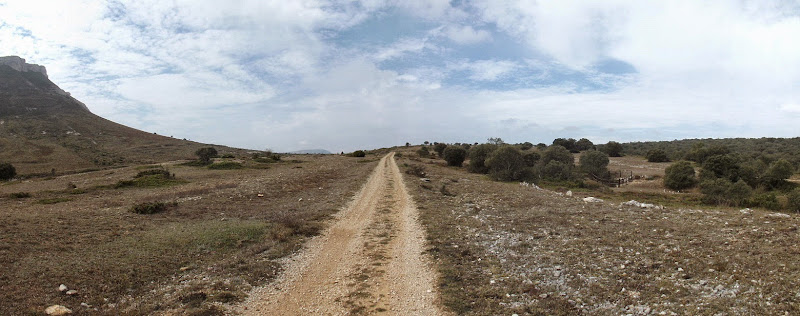A fantastic vista through a natural window.
INTRODUCTION
"El Ventanón" is a natural bridge carved into a limestone ridge. The geological origin must be sought into the fact that water streams often sink into gaps which are located close to the edge of a limestone plateau. When such a stream dissolves a lot of limestone it can form a short but very large cave. The "El Ventanón" bridge is what remains of the roof of such a cave. The stream literally flowed below the bridge. The bridge of "El Ventanón" has a length of 30 meters and a height of 20 meters and is several meters wide. On the left side of the bridge we have found some small caves, which is an additional indication of a solutional cavernous origin of this bridge.
This geological phenomenon is included in a local walking route called the PRC-BU 32, which starts at the Ojo Guareña cave. Part of his cave, with a total length of more than 110 kilometers (110,000 meters) of galleries is one of the longest caves of Spain, can also be visited as a show cave.
READ FURTHER AND ENJOY THE PHOTOS.
THE LOCATION
The Google Map of below shows the location of the starting point of our walk: the village of Villamartín de Sotoscueva. The village is situated in the Cantabrian Mountains of northern Spain, between the cities of Bilbao, Santander and Burgos. After parking the car (lots of space) we leave Villamartín in a westward direction, following the PRC-BU 20. This local hike, which starts at the Ojo Guareña cave, leads us directly to "El Ventanón". Because the natural bridge of "El Ventanón " is the main goal of today, we only walk half this route. Nevertheless check the track with its accompanying maps (topographic map, Google maps and Google Earth), because it gives very accurate information.
THE HIKE
The village of Villamartin is situated on one of those typical cuestas that are so common in this area. A cuesta is formed by a hard and resistant formation of rock with a small dip. This low angle of rock inclination favors the forming of rock plateaus. In this case the plateau is composed of limestone, a rock that is soluble in water. In limestone areas almost all the rain disappears directly under the ground, flowing through fractures and creating stalactite caves. In Spain this process of underground draining often leads to a typical stony and arid environment, something we do not know in the Netherlands.
A look back at the path we used to leave the village Villamartín some 5 minutes ago.
This photo shows the stony character of a limestone area in Spain.
The path rises gradually to a low pass. The underground drainage has a very specific effect on the local flora. The natural vegetation would have been a vast forest of evergreen oaks (Quercus ilex), as still can be seen on our right hand. However, deforestation and centuries of grazing resulted in the arid surface to our left.
The fence surrounds the pothole of Cueva García, with a depth of many tens of meters. The fence should ensure that both livestock and curious tourists do not fall down.
On the pass we leave the stony path and we take a more adventurous track that curves to the right (at this place the natural bridge "El Ventanón" is already indicated), in the direction of the forest with the evergreen oaks.
Some parts of this forest still consists of relatively young trees and bushes. This is due to the depopulation of the region leading to a sharp decline of the grazing activities. It´s true that where the presence of man seizes nature takes its chance again. By this I do not mean that every human intervention is bad. For example, many of those arid places caused by grazing, are real orchid paradises, that would not exist if everything would be covered with forest. On the other hand, excessive use of land rarely leads to anything good.
We are now very close to the edge of the plateau. What is this?
When we come still a little bit closer, there suddenly appears a big hole.
The natural bridge "El Ventanón" offers a beautiful vista on the valley below. The origin of this geological phenomenon has been described at the beginning of this post.
The bridge as seen from the other side. The bridge is several meters wide. In addition, there can be seen a number of small caves, suggesting a karst origin (solution of limestone by water).
The bridge as seen from the left. The top is covered with cheerful, though not so tiny shrubs. The height of the "El Ventanón" is about 20 meters, at least according to the information board that stands nearby.
This overview picture shows the high "sociability content" of this spot. Also a great place for lunch.
After enjoying this lovely place followed a thorough examination of the immediate surroundings, which led to the discovery of the Nejuelos cave (also shown on the map). After visiting this cave it is time to go back.














een prachtige wandeling naar een fantastisch "venster" in het gebergte!
ReplyDeletegroetejs uit België
That is a really interesting natural formation and it frames the picture perfectly .
ReplyDelete